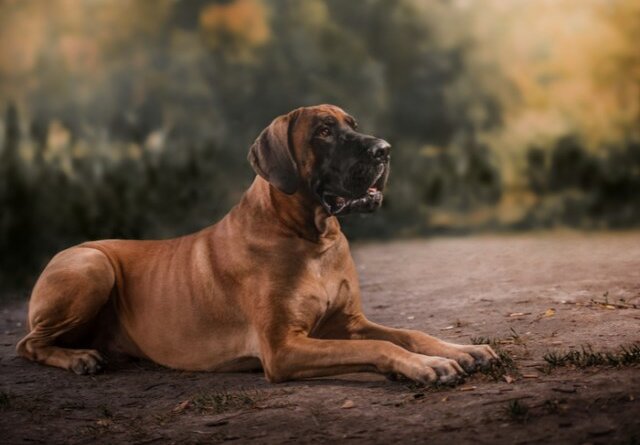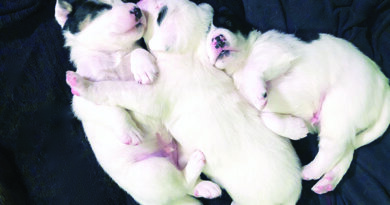Great Dane Dog Breed Profile
The Great Dane dog breed used to be iconic in the 1970s. But the registration for this dog plummeted by 69% since 1980. In a world where smaller breeds are preferred, is raising a giant dog still worth it?
In this article, we’ll give you an insight into the Great Dane’s world and help you see why this underrated gentle giant deserves to be on your dog option’s list.
We’ll also discuss the Great Dane’s:
- Characteristics, personality, and appearance
- History, background, and average lifespan
- Common health problems and some tips on how to prevent it
If you’re planning to adopt Great Dane puppies or dogs, this article will help you make a wise and informed decision.
So, without further ado, let’s discover what this breed can do for you.
What is a Great Dane Dog?
Great Dane is a giant and smooth-coated but gentle dog. They are commonly referred to as an “Apollo of Dogs,” which means that they are great of them all.
And they are more than just their size.
Despite their large size, they show loyalty and excellent companionship among their human family.
They might look intimidating, but you’ll be surprised by how good they are compared to other dog breeds.
Now let’s find something interesting on the characteristics of this Great Dane.
Characteristics of a Great Dane Puppies and Dogs
These Great Dane puppies may look scary when they grow mature. But this dog has a great personality. They’re playful and might rather play than fight with other dogs.
Typically, these huge dogs are loving, friendly, outgoing, protective, and loyal. They’d love spending time with you rather than doing anything. So it’s beautiful to add them to your growing family.
Another thing that makes Great Dane one of the best pets is their level of tolerance. They don’t mind children playing with them.
But, supervision is also needed when children are hanging out with them.
There might be some truculent Great Danes, but they are not properly socialized and trained. And in some instances, you might find an unfriendly one, but if you earn their trust, they will be calm.
So, if you’re planning to adopt one, it’s essential to train and socialize them as they grow more prominent and well-rounded.
Thankfully, taking care and training Great Dane puppies is not hard. They require big spaces to roam around because of their size. And they need more exercises to keep them healthy and fit.
But like the other dog breeds, caring for these Great Danes puppies also requires a commitment and big responsibility.
Physical Appearance of a Great Dane Puppies and Dogs
Great Dane puppies look cute, but you might feel intimidated seeing them as they grow more prominent. But as mentioned above, that’s only their looks, not their personality.
To help you identify a Great Dane, let’s discuss their appearance one by one.
Body
You might think of them as an adult based on their size, but they grow faster. They don’t stay small for a very long time.
After adopting adorable little Great Dane puppies, you might find them turning adolescent with a long and weird look.
Their body coats are always short, and their color may vary. Below is the list of different Great Dane coat colors:
- Fawn – it is a golden color, but it has a black mask on its face and ears
- Brindle – a combination of golden and black color in whole parts of their body
- Blue – it’s not the blue color, but a shade of gray color.
- Harlequin – a combination of white and patches of black that looks like cookies and cream.
- Mantle – also white mixed solid black color
- and lastly, Black
Head
Great Dane’s head grows symmetrical to their body. And they are always long-faced and have big floppy ears.
Height and Weight
Male Great Dane could grow up to 30 to 34 inches tall and weigh around 120 to 200 pounds. On the other hand, the female could grow 28-32 inches tall and weigh 100 to 130 pounds.
No wonder why this breed is recognized as the tallest breed of all time.
One proof is Freddy, a Great Dane who is currently the record holder of the Tallest Dog title from Guinness World Record, which Zeus previously held.
Tail
They usually have a long tail. But it’s not just long; it’s also powerful. Since Great Dane used to have a “happy tail,” they always wagged it very hard.
Great Dane Dog Lifespan
You might wish to spend a longer time with your incredible Great Dane dogs. But sadly, isn’t long-living
According to the American Kennel Club, Great Danes’ lifespan ranges between 8 to 10 years.
Unfortunately, some Great Danes could only live around 6 to 7 years, and some of them died earlier than that.
Two significant factors can influence their lifespan – serious health problems and accidents.
Sadly, Freddy and Zeus, the Great Danes mentioned above, were one of them.
Zeus has only lived five years while Freddy succumbed to death after spending eight years with his human family.
There are some Great Danes that are lucky to live up to 12 years. But, still, these instances are rare, and they still have a shorter lifespan compared to other small breed dogs.
Researchers are trying to understand this phenomenon, but they can’t find a particular answer.
So it’s essential to take good care of your Great Dane puppies’ and spend time with them while they’re alive and kicking.
Training and exercise and a proper diet would also help them stay active and healthy while growing.
What to Feed Great Dane Puppies and Dogs
Diet and nutrition are significant for your rapidly growing Great Dane puppies and dogs. Good food means a good life for them. So, paying attention to the foods you’re feeding would be of great help.
And of course, the amount of food for your Great Dane varies on their age and gender. The bigger they grow, the needier they become.
At the first four months of your Great Dane puppies, they could have three meals a day. But after that, giving two meals per day is enough.
According to the Dog Advisory Council, your Dane could eat up to 8 – 10 cups of food daily. But of course, your puppies would eat lesser than that amount.
For the first 1-6 weeks of your Great Dane puppies, they can eat up to 2-4 cups a day. In their 2 to 6 months old, they could have 5 to 8 cups per day. And as they grow bigger, they could have 8-9 cups of dog food a day.
But, feeding them too much could cause bloating. So, consulting your vet would help you know what and how much food would be best for your dog.
How to Care for Great Dane Puppies and Dogs
If you’re planning to purchase or adopt a dog, please know that you’ll be carrying a huge responsibility on your shoulders. Great Dane puppies and dogs need extensive care, effort, and time as they grow.
Aside from giving them proper food and doing exercises, it’s also essential to maintain good hygiene.
Grooming Great Dane Puppies and Dogs
Grooming Great Dane puppies may be easy. However, as they grow larger and larger, it takes more time to do it.
As you can expect, bathing them is a difficult chore, especially if they aren’t looking forward to it.
And sometimes, your Great Dane puppies will attempt to get out of a bath by hiding beneath the kitchen table. But over time, they will get used to that.
From time to time, they shed a lot, especially during the spring and fall seasons. But with frequent brushing with a stiff bristle brush and Shampoo, their coat may be kept in good condition.
Brushing your Great Dane’s coat regularly also reduces the number of washes they require.
Get your Great Dane puppies acclimated to being brushed and examined. Handle their paws and glance inside their mouth frequently because dogs are sensitive about their feet.
To keep your dog’s nails healthy and prevent them from breaking or tearing, you should trim them every couple of weeks.
Brush your dog’s teeth at least a couple of times per week to maintain healthy oral hygiene. It would help them prevent gum diseases.
Common Health Problems of Great Dane Puppies and Dogs
Great Danes are typically healthy, but they are susceptible to some health issues, like other breeds. Although not all Danes may acquire any or all of these illnesses, it’s vital to be aware of them.
They are also prone to several hereditary health issues. So if you’re thinking about getting one, try considering it.
These are some of the health issues your Great Dane puppies and dogs might acquire.
Gastric Dilatation – Volvulus (GDV) or Gastric Torsion
This condition, commonly called “bloat,” affects almost any giant breed, including the Great Dane.
It occurs when they’re eating too many meals, eating rapidly, drinking a lot of water afterward, and exercising actively. This causes the cutting of blood supply to the stomach and spleen.
It can be deadly if not treated immediately. So, if you notice that your Great Dane is showing symptoms of this disease, promptly go to your vet for a further diagnosis.
Hip Dysplasia
This condition is hereditary and shared in all dog breeds. So your Great Dane might also suffer from this.
It usually occurs when their hip joints don’t fit with their thighbone in their rear legs. The X-ray screening is the only one that can determine it. So, immediately call your vet if any swelling or discomfort is observed on your Great Danes.
Osteosarcoma
Cancer on the bones of a Great Dane. They might develop tumors when they’re still puppies. Chemotherapy can treat it, and luckily they could live after that treatment.
Heart Disease
Heart disease in dogs has different varieties. Treatment varies on that and their capacity and strength. So if your Great Dane shows any signs, take them to your vet.
Related Article: 4 Heart Problems in Dogs: Signs, Causes, and Treatments
Where to Find Great Dane Puppies and Dogs
Great Dane puppies and dogs are frequently bought without a clear grasp of what it takes to own one. Luckily, there are many Danes available for adoption or fostering and several rescue organizations.
American Kennel Club (AKC) sets out the highest breed standard for all Great Danes that responsible breeders should follow. Health problems are less likely to be passed down to dogs bred to these criteria.
Here are some rescue organizations that you could trust when purchasing or adopting Great Dane puppies.
- Great Dane Club of America (GDCM)
This organization has responsible members that strictly follow the breeding practices to ensure the vitality and longevity of Great Danes.
It is different from the GDCM. They are dedicated to giving safe and comfortable homes for those Great Danes they have rescued.
This organization is the best location for those near Ohio to find Great Dane puppies and dogs. They have many Great Danes who deserve to have a good and comfortable home.
They are a nonprofit organization that is dedicated to providing medical attention and care for abandoned Great Danes. They also provide temporary shelter for those adoptable Danes and a permanent sanctuary for those who are not.
They are volunteers passionate about rescue, rehome, and rehabilitating Great Danes all over the country.
This location is best for those who want to adopt a Great Dane in South Carolina.
If your location does not have a rescue listed, contact the national breed group or a local breed club to direct you to a Great Dane rescue.
Great Dane Dog History
You might be wondering where these Great Danes came from. Well, based on the historical story, they originally came from Germany, not in Denmark. And they used to be called Deutsche Dog or the “German Dog.”
These Danes were once known for their bravery when they were used to hunting dangerous wild boars in the past.
And now, they have become known as guardians of their homes and loved ones, a role they continue to enjoy.
Back then, Great Danes were prominent protectors of estates and carriages in the 18th century. Few other dogs could bring down a wild boar.
Therefore, they were popular with the upper class for sport.
This breed was believed to have existed almost 400 years ago and descended from different breeds such as English Mastiffs and Irish wolfhound.
In the 1700s, the name Great Dane arose. It happened when a French naturalist came to Denmark and saw a Boar Hound who looked like Greyhound. He named the dog Grand Danois, which later became Great Danish Dog.
But, the name of Great Danes depends on what country they belong to. Some European countries called them Deutsche Dog, while English countries use the term Great Danes.
In 1887, the American Kennel Club officially recognized this breed.
Great Danes became very popular until now, mainly due to the show Scooby-Doo and the comic-book character Marmaduke.
Conclusion
Great Danes are giants, but they are gentle giants. Therefore, don’t be fooled by their immense size. They’re amicable with other animals, and they love playing and cuddling with kids.
Yes, they can still become aggressive. But with some training and mentally stimulating activities, you can keep their temper in control.
Nevertheless, they can still be fantastic family pets who can shower your family with love and protect you.
But as we’ve said earlier, the bigger the dog is, the needier they become.
So, before you embark on a fantastic journey of Great Dane ownership, kindly make sure that you have the means to provide for his needs.
READ NEXT: Best Dog Food for Great Danes: 6 Vet Recommended Brands
The post Great Dane Dog Breed Profile appeared first on Top Dog Tips.













